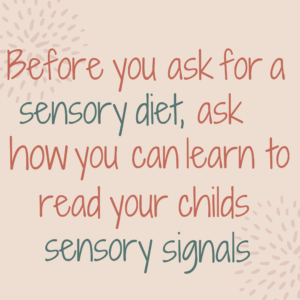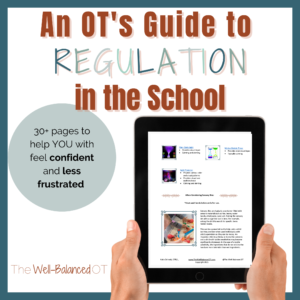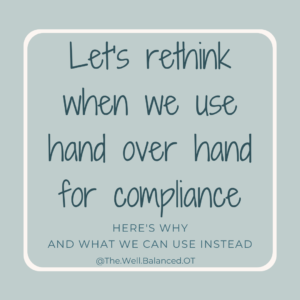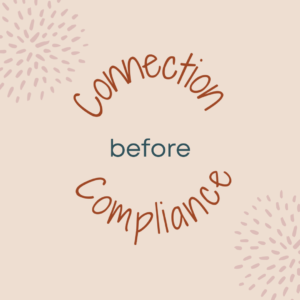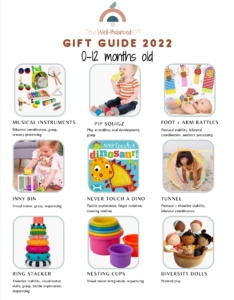Before you ask for a Sensory Diet, ask your OT how you can learn to read your child’s sensory signals.
“Sensory Diet” is a huge buzz word these days.
For those that aren’t sure what it means, it’s basically a plan of sensory activities done at prescribed times to ‘feed’ the nervous system with input it needs to remain regulated. The thought is that if we provide safe and functional activities, most often with greater intensity, the child will not need to seek the input in unsafe ways.
But even more important than a sensory diet is the ability to identify a child’s sensory signals.
What does their body look like when it is feeling overwhelmed? Do they have a sign that they are about to shut down? Can we tell when they are fully regulated?
Learning how to read your child sensory signals is so important to understanding what sensory input they need and when. Sure, an OT can specify activities that you complete every two hours, but a parent needs to be aware if an activity should be shortened because it’s over stimulating a child or if an activity that typically regulates is no longer doing its job. Your OT can only be present with your child for, typically, 60 minutes a week. The rest of that time, the caregiver is responsible for implementing these strategies. So let’s empower them!
There are obvious signals like screaming or running away, but there may be less obvious signs that could be easily missed. First, every single child is different so not all of these signals will indicate dysregulation.d

Sensory Signals – Attention Abilities:
Do they:
- Have trouble attending to multiple activities?
- Need to run away for a minute or two before re-engaging with someone?
- Throw toys instead of play with them?
Sensory Signals – Communication:
- Is the child using a high pitch voice?
- Do you notice an increase in baby talk when in a new environment?
- Are they scripting?
- Has their voice disappeared when they normally use one?
- Do they place their hands over their ears (I’ve found that kids do this to limit all input or indicate they do not like something that is happening – it’s not just a reaction to auditory input).
Sensory Signals – Facial Clues:
- Fllat affect (minimal facial expressions or reactions?
- Excessive laughing or silliness?
- Close their eyes to tune out their surroundings?
- Flushed cheeks?
- Sweating more than typical?
Sensory Signals – Body Clues:
- Does their body go into extension (straighten and stiffen)?
- Closed fists?
- Hold onto toys in both hands frequently?
- Have hands by their face?
- Hiccups?
- Holding their breath or using shallow breaths?
- Teeth grinding?
Starting to pay attention to these small clues will help you pinpoint when the dysregulation starts, when it heightens and when they become more regulated. It will help you begin to understand the child’s triggers and what helps calm them. I often recommend my clients keep a daily journal of their child’s sleep, activities, and behaviors they notice throughout the day. Then, take that information to your Occupational Therapist so that you can collaborate on what activities are best for your child.
I’ve created visuals, available in my Freebie Vault, that will help you determine if your child has challenges within different sensory systems. Join my mailing list for free access!
Guide to Regulation
If you work in the schools or would like to provide a resource to your child’s teacher I highly recommend looking into my new e-book: An OT’s Guide to Regulation in the Schools.
I created An OT’s Guide to Regulation in the Classroom to support teachers, mental health staff, therapists, and other OTs. A student can not learn if they are dysregulated and you can’t teach if there are disruptions occurring throughout your lessons or therapy sessions. This guide begins by teaching school staff how to identify when and why a student is dysregulated and how to suggest specific regulation strategies and tools support an optimal state for learning.
This 30+ page, no fluff guide is written by an Occupational Therapist. We are experts in regulation, sensory processing, and looking at the whole child. That means looking at multiple factors to help you decide the perfect tool for your students.
What’s included:
- Commonly used definitions
- 36 links to preferred regulation tools to use in the school
- Education on low and high arousal behaviors to understand beginning signs of dysregulation
- Alerting and calming activities to facilitate a just right state
- Components that can impact regulation
- Our 8 sensory systems broken down into observable behaviors to help us identify its impact on regulation
- Strategies for modifying the environment and organizing a students personal space
- A look at adapted seating (when and how to use it)
- Appropriate regulation tools (with links) for the classroom vs. Individual setting
- Education on oral tools and regulation garments,
- When and how to utilize heavy work and breath work
Putting it all together:
- How to teach the child how to utilize the strategies
- Quick Reference Decision Making Guide
If you’re still feeling unsure, connect with your OT to figure out what sensory signals you child demonstrates. Until then, check out Understanding your Childs Sensory Signals by Angie Voss and Raising a Sensory Smart Child by Lindsey Biel.

